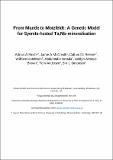From Mantle to Motzfeldt : a genetic model for syenite-hosted Ta,Nb-mineralisation
Abstract
A genetic model for the Motzfeldt Tantalum-Niobium-rich syenite in south-west Greenland, considered to be one of the world’s largest Ta prospects, is presented. The Motzfeldt primary magma formed early in regional Gardar (1273 ± 6 Ma) rifting. Isotope signatures indicate that the Hf had multiple sources involving juvenile Gardar Hf mixed with older (Palaeoproterozoic or Archaean) Hf. We infer that other High Field Strength Elements (HFSE) similarly had multiple sources. The magma differentiated in the crust and ascended before emplacement at the regional unconformity between Ketilidian basement and Eriksfjord supracrustals. The HFSE-rich magmas crystallised Ta-rich pyrochlore which formed pyrochlore-rich crystal mushes, and it is these pyrochlore-rich horizons, rich in Ta and Nb, that are the focus of exploration. The roof zone chilled and repeated sheeting at the roof provided a complex suite of cross-cutting syenite variants, including pyrochlore microsyenite, in a ‘Hot Sheeted Roof’ model. The area was subject to hydrothermal alteration which recrystallized alkali feldspar to coarse perthite and modified the mafic minerals to hematite, creating the friable and striking pink-nature of the Motzfeldt Sø Centre. Carbon and oxygen isotope investigation of carbonate constrains fluid evolution and shows that carbonate is primarily mantle-derived but late-stage hydrothermal alteration moved the oxygen isotopes towards more positive values (up to 21‰). The hydrothermal fluid was exceptionally fluorine-rich and mobilised many elements including U and Pb but did not transport HFSE such as Ta, Hf and Nb. Although the U and Pb content of the pyrochlore was enhanced by the fluid, the HFSE contents remained unchanged and therefore Hf isotopes were unaffected by fluid interaction. While the effect on hydrothermal alteration on the visual appearance of the rock is striking, magmatic processes concentrated HFSE including Ta and the hydrothermal phase has not altered the grade. Exploration for HFSE mineralisation commonly relies on airborne radiometric surveying which is particularly sensitive to the presence of U, Th. A crucial lesson from Motzfeldt is that the best target is unaltered pyrochlore which was identified less easily by radiometric survey. Careful petrological/mineral studies are necessary before airborne survey data can be fully interpreted.
Citation
Finch , A A , McCreath , J A , Reekie , C D J , Hutchison , W , Ismaila , A , Armour-Brown , A , Andersen , T & Simonsen , S L 2019 , ' From Mantle to Motzfeldt : a genetic model for syenite-hosted Ta,Nb-mineralisation ' , Ore Geology Reviews , vol. 107 , pp. 402-416 . https://doi.org/10.1016/j.oregeorev.2019.02.032
Publication
Ore Geology Reviews
Status
Peer reviewed
ISSN
0169-1368Type
Journal article
Description
This research summarises many years of field and lab studies on the area, but the most recent work (2016) has received funding from the European Union’s Horizon 2020 research and innovation programme (grant agreement No 689909).Collections
Items in the St Andrews Research Repository are protected by copyright, with all rights reserved, unless otherwise indicated.

